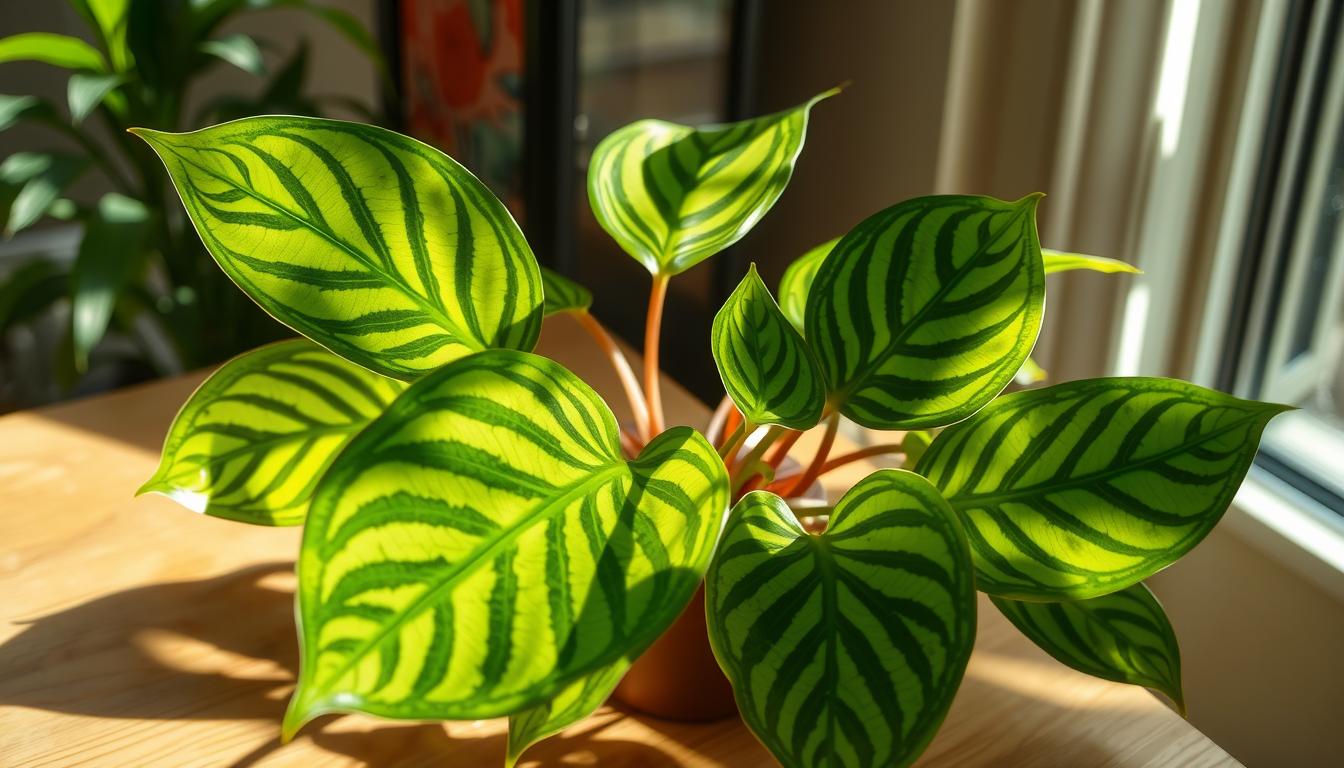I’ve always loved plants, and the prayer plant is one of my favorites. Its leaves move like they’re praying, adding beauty to any room. If you’re drawn to this plant, you’re in the right spot. We’ll cover everything you need to know about prayer plant care.
Key Takeaways
- Prayer plants, also known as Maranta leuconeura, are popular tropical houseplants native to Central and South America.
- They are known for their unique leaf movement, folding up at night like praying hands.
- Prayer plants require specific care in terms of light, temperature, humidity, and watering to thrive.
- Proper soil, fertilization, and repotting are also essential for keeping prayer plants healthy and happy.
- With the right knowledge and attention, prayer plants can be a rewarding and low-maintenance addition to your indoor garden.
Table of Contents
Understanding Prayer Plants: Origins and Characteristics
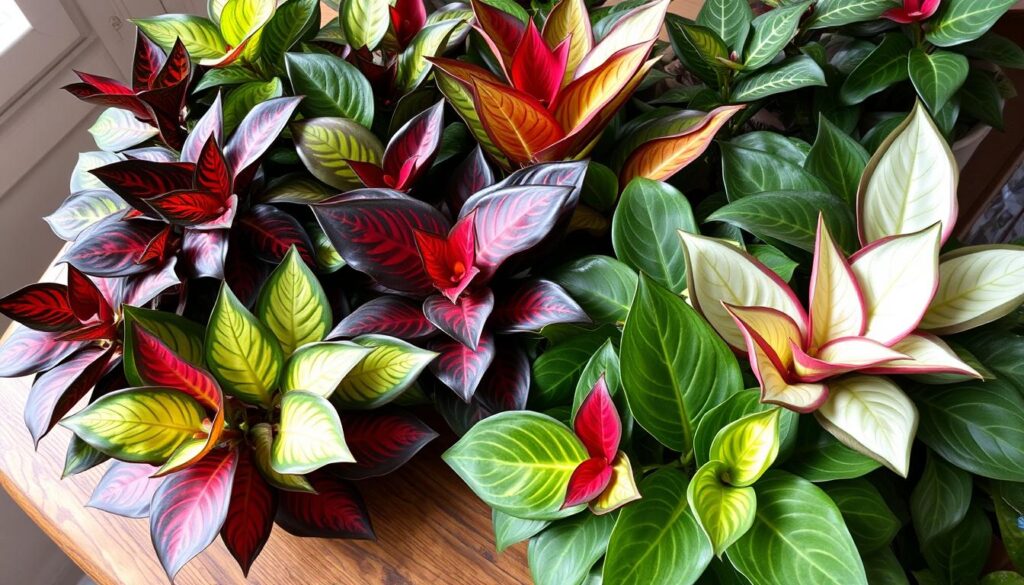
Prayer plants, also known as Maranta, are tropical plants from South America’s rainforests. They are loved for their leaves that fold up at night and open in the day, a move called nyctinasty. This unique behavior makes them a favorite in indoor gardens.
Native Habitat and Natural Growth Patterns
In the rainforest, prayer plants love the dappled sunlight. They grow 6-12 inches tall. These plants are safe for homes and belong to the Marantaceae family. Their leaves are oval, with patterns and colors like green, red, pink, and white.
Different Types of Prayer Plants
- Maranta leuconeura ‘Erythroneura’ (Red Prayer Plant)
- Maranta leuconeura ‘Lemon Lime’
- Maranta leuconeura ‘Kerchoveana’ (Rabbit’s Foot Plant)
Other plants like Calathea, Stromanthe, and Ctenanthe are related. They need similar care and have similar traits.
The Unique Movement of Prayer Plant Leaves
The leaves of prayer plants fold up at night and open in the day. This nyctinastic behavior helps them control temperature and moisture. It’s perfect for their humid, shaded home in the rainforest.
Essential Prayer Plant Care Requirements
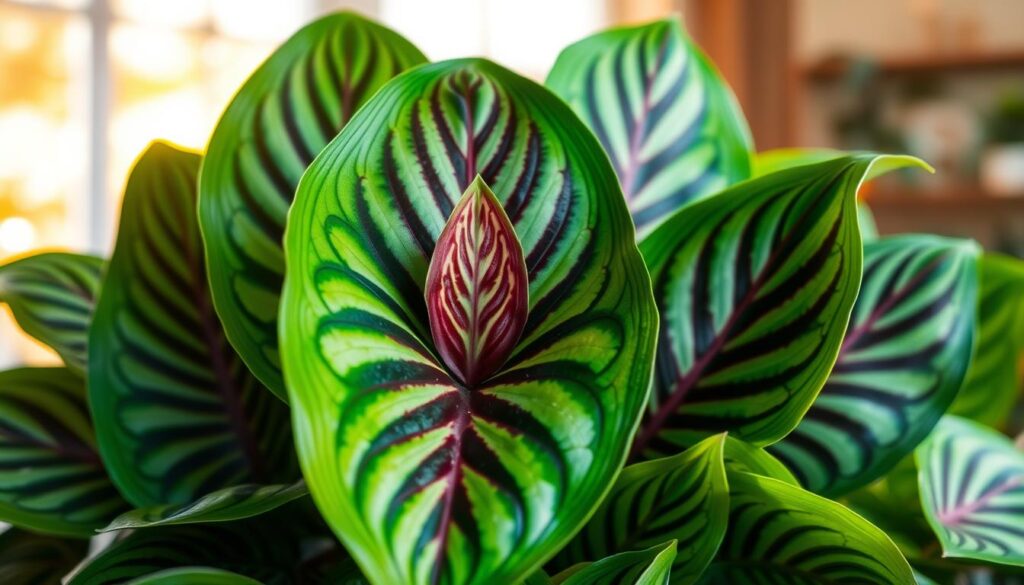
Keeping your prayer plants, also known as Maranta, healthy is key. They need the right environment to grow well indoors. Knowing their care needs helps keep them vibrant and healthy.
Prayer plants love bright, indirect light. They do best in spots with plenty of sunlight but avoid direct harsh rays. This can burn their leaves. So, choose a spot with bright, filtered light all day.
It’s essential to keep the soil moist, but avoid making it too soggy. Water the plant only when the top inch of soil is dry to prevent overwatering.
These tropical plants need high humidity. Aim for 50-60% humidity for the best growth. You can increase humidity by misting the leaves, using a pebble tray, or placing the plant in a humid room like the bathroom.
Maranta plants thrive in temperatures ranging from 65°F to 75°F (18°C to 24°C) during the day, and prefer slightly cooler conditions at night. Avoid sudden temperature shifts or drafts to minimize stress.
Use a potting mix that drains well, like a peat-based one. This prevents waterlogged roots. Repot your plant every 1-2 years, or when it becomes root-bound or outgrows its pot. This gives it fresh soil and encourages growth.
During spring and summer, fertilize monthly with a balanced, water-soluble fertilizer. Dilute it to half strength. This supports the plant’s growth and keeps the leaves vibrant.
By following these care tips, you can create a great environment for your Maranta. They will thrive and show off their beautiful leaf movements and patterns.
Light and Temperature Requirements
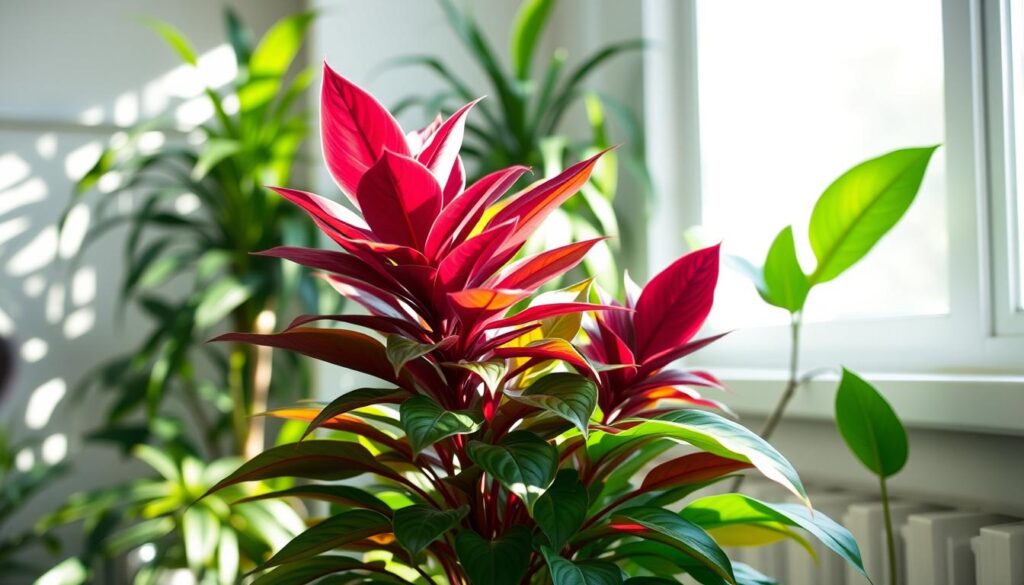
Prayer plants, also known as Maranta, love medium to bright indirect light. This is similar to the dappled sunlight they get in their natural habitat. East or north-facing windows are best for them. Direct sunlight can burn their leaves and fade their colors.
Keeping the right prayer plant light requirements is key for their health and color. This helps keep the plant healthy and vibrant.
The best Maranta temperature needs are between 60°F to 85°F (15°C to 29°C). Don’t put them near drafts, air conditioning vents, or heaters. Sudden changes in temperature can stress them out and cause problems.
Managing Seasonal Changes
In winter, when they grow slower, water and fertilize them less. Maintain a consistent temperature and ensure the air is adequately humid. This helps with the dry air from heaters. Knowing their seasonal needs helps your Maranta thrive all year.
| Light Requirements | Temperature Range |
|---|---|
| Medium to bright indirect light | 60°F to 85°F (15°C to 29°C) |
By meeting the prayer plant light requirements and Maranta temperature needs, you create the best environment. This lets these beautiful plants grow well and show off their unique leaf movements.
Watering and Humidity Needs
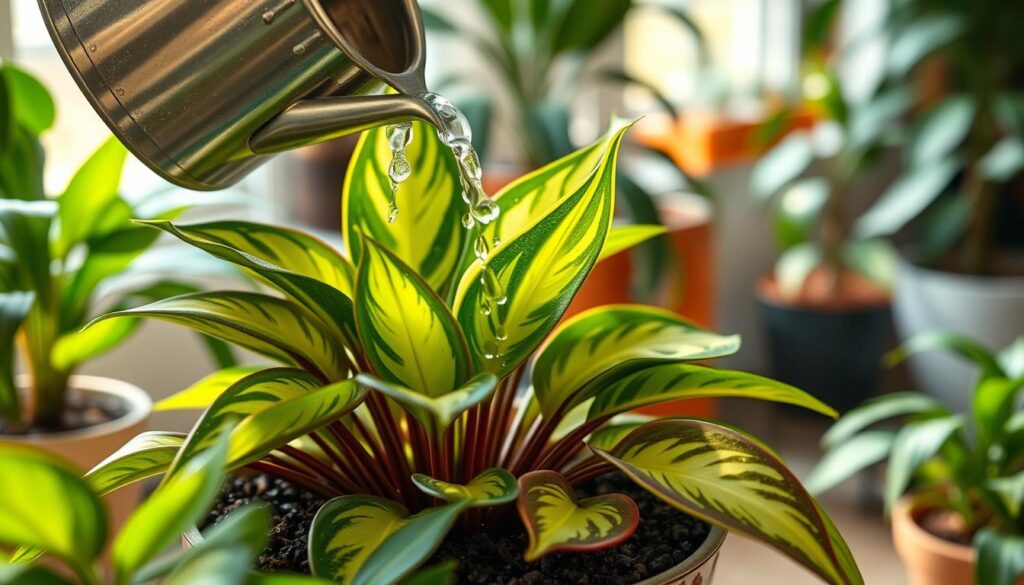
Proper watering and humidity levels are key for your prayer plant’s health. These tropical plants love moist soil but avoid overwatering to prevent root rot.
For prayer plants, ensure the top inch of soil is dry before watering.This is usually every 7-10 days. Make sure the soil doesn’t dry out completely, as it can stress the plant. Prayer plants do best in humid environments, aiming for 50-70% humidity.
To boost humidity, use a humidifier, mist the leaves, or place the pot on a pebble tray with water. Grouping plants together can help create a more humid environment. Watch for signs of low humidity, like brown, crispy leaves, and adjust your care as needed.
| Watering Frequency | Ideal Humidity Level |
|---|---|
| Water when the top inch of soil feels dry, typically every 7-10 days | 50-70% |
By balancing water and humidity, your prayer plant will thrive. Remember, these plants are sensitive to both too much and too little water. Pay attention to your plant’s needs and adapt your care routine accordingly.
Soil Requirements and Potting Tips
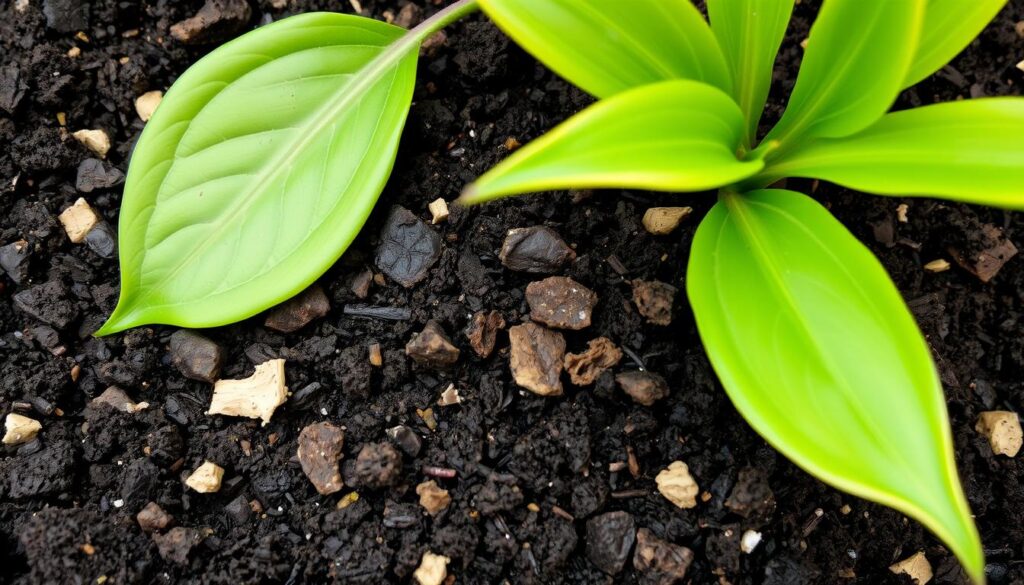
To keep your prayer plants happy, start with the right soil. They love a mix that drains well and is peat-based. Add perlite or vermiculite for extra help. The soil should keep moisture steady but not too wet. Aim for a pH of 5.5 to 6.0, slightly acidic to neutral.
Best Soil Mixtures for Prayer Plants
For a top-notch mix, blend peat moss, perlite, and potting soil in equal parts. A bit of lime dust can help with pH balance. This mix keeps roots healthy with the right amount of moisture and air.
Choosing the Right Pot Size
When repotting, pick a pot only 1-2 inches bigger than the old one. Prayer plants like a snug fit. Make sure the new pot has holes for drainage to avoid waterlogged soil.
Repotting Guidelines
- Repot your plant every 1-2 years, or when it outgrows its container.
- Spring is the best time for repotting, as plants are growing fast then.
- Carefully remove the plant and loosen any tight roots.
- Put the plant in the new pot and fill with fresh soil mix.
- After repotting, water thoroughly to help the plant acclimate to its new pot.
With the right soil, pot size, and repotting schedule, your prayer plants will flourish. They’ll keep you entertained with their beautiful leaf movements.
Fertilizing and Nutrition Guidelines
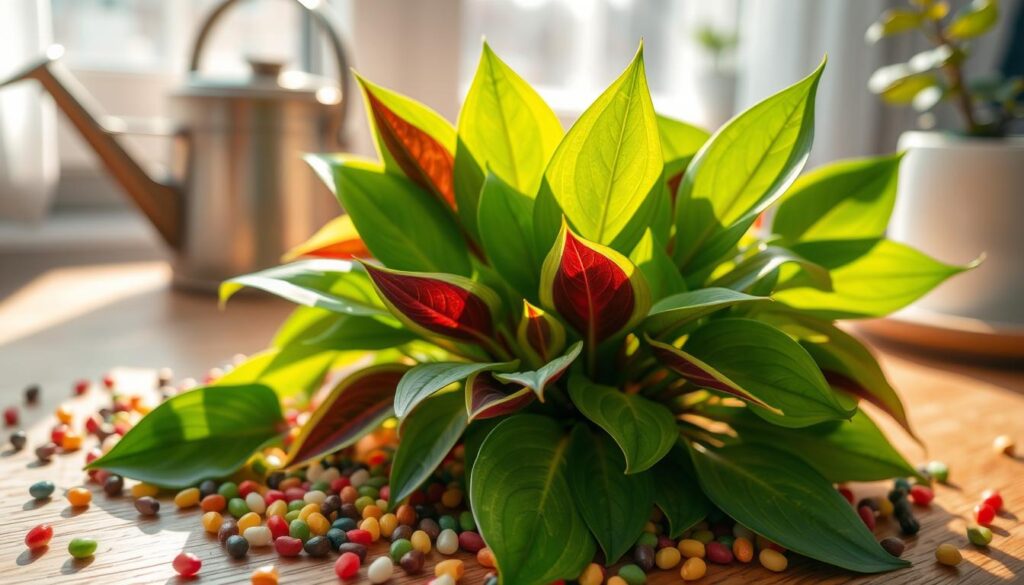
To keep your prayer plant (Maranta) healthy, you need to fertilize it right. These plants thrive on the right nutrients. This keeps their leaves bright and their movements lively.
In spring and summer, when they grow fast, fertilize your plant every month. Use a balanced, water-soluble fertilizer but only at half-strength. Stop fertilizing in winter when they grow slower.
Too much fertilizer can harm your plant’s roots. It’s safer to under-fertilize than to risk damage. If your plant’s leaves look pale or it’s not growing well, it might need more food.
Flush the soil with plain water now and then. This removes any leftover fertilizer salts. It keeps your plant’s roots healthy and happy.
| Nutrient Ratio | Recommended Range |
|---|---|
| Nitrogen (N) | 3% |
| Phosphorus (P) | 1.5% |
| Potassium (K) | 1.5% |
By following these prayer plant fertilizer tips, your Maranta plant will get the best nutrition. This will help it thrive and show off its beautiful leaf movements.
Prayer Plant Propagation Methods
If you love the striking leaves of prayer plants (Maranta leuconeura), you’ll be excited to learn how to propagate them. These plants are easy to grow and can be split into two main ways: division and stem cuttings. Knowing the best methods will help you grow more plants or share them with others.
Division Technique
Division is a simple and reliable way to grow more prayer plants. It’s best done in early spring when the plant is growing fast. Just split the plant’s roots into sections, making sure each part has healthy roots and leaves.
Then, replant these sections in moist potting mix. Keep the soil wet until you see new growth.
Stem Cutting Method
Stem cuttings are another great way to grow prayer plants. Cut a 4-6 inch piece from the plant just below a leaf node. Dip the cut end in rooting hormone and place it in water or moist potting mix.
Maintain moist soil and place the cutting in a spot with bright, indirect sunlight. It should take about a month for new roots to grow.
Best Time for Propagation
The best time to propagate prayer plants is in spring and early summer.This marks the plant’s most active growth period. It gives the new plants time to grow strong roots before the cooler months.
By using these easy methods, you can grow more prayer plants and share them with others. Make sure the new plants get enough moisture, humidity, and light. With the right care, your prayer plants will thrive for many years.
Common Growing Problems and Solutions
Prayer plants (Maranta) are lovely, but they face some challenges. Knowing how to tackle prayer plant problems and Maranta plant care issues is crucial. This way, you can keep your indoor space lush and healthy.
Brown leaf tips are a common issue. They often stem from low humidity or uneven watering. To fix this, make sure your plant’s environment is humid. Also, water it deeply when the soil feels dry an inch down.
Yellowing leaves can signal too much water or a lack of nutrients. Avoid watering again if the soil is overly wet; allow it to dry first. Also, using a balanced houseplant fertilizer can help with nutrition.
- Spider mites and mealybugs are common pests that may cause issues. Eliminate them using neem oil or an insecticidal soap solution.
- Too much water can cause root rot. Ensure the soil drains properly and prevent waterlogging.
- Leaf curling might mean your plant is stressed from temperature extremes. Modify its environment to keep the plant comfortable.
| Common Issue | Possible Cause | Solution |
|---|---|---|
| Brown leaf tips | Low humidity, inconsistent watering | Increase humidity, water thoroughly when top inch is dry |
| Yellowing leaves | Overwatering, nutrient deficiency | Allow soil to dry out, apply balanced fertilizer |
| Pest infestations | Spider mites, mealybugs | Treat with insecticidal soap or neem oil |
| Root rot | Overwatering, poor drainage | Improve drainage, allow soil to dry before watering |
| Leaf curling | Temperature stress (heat or cold) | Adjust temperature to optimal range |
By quickly solving these prayer plant problems and Maranta plant care issues, your plant will flourish. It will keep you enchanted with its lively leaves and colors.
Conclusion
Prayer plants are a joy to have indoors. They move their leaves in a captivating way and add a tropical touch. By following the care tips in this guide, you can make your Maranta plants thrive.
These plants need the right light, water, and humidity. They also need the right nutrients. Taking these steps will help your prayer plants grow well.
A variety of prayer plant species are available to suit your preference. You can pick the Red, Black, or Green Prayer Plant. These plants are easy to care for and enhance the beauty of any room.
They are also safe for homes with pets or kids. With good care, your plants will grow lush and move their leaves in a magical way. This brings a bit of the tropics into your home.
To keep your Maranta plants happy, keep the soil moist and provide enough humidity. Fertilize them at the right times too. These plants are also easy to share by dividing them.
So, enjoy the beauty of prayer plants. They can make your indoor space feel like a tropical paradise.
FAQ
What are the light requirements for prayer plants?
Prayer plants need medium to bright indirect light. East- or north-facing windows provide ideal light conditions for them.Direct sunlight can harm their leaves and fade their colors.
What is the optimal temperature range for prayer plants?
The best temperature for prayer plants is between 60-85°F (15-29°C). Keep them away from areas with drafts, heating units, or cooling vents to protect them from temperature fluctuations.
How often should I water a prayer plant?
Water your prayer plant when the top inch of soil is dry. This is usually every 7-10 days. Overwatering may lead to root rot in your plant.
What type of soil do prayer plants prefer?
Prayer plants like well-draining, peat-based potting mix. Add perlite or vermiculite for better drainage. They grow best in soil with a pH range that is slightly acidic to neutral.
How often should I repot a prayer plant?
Repot the prayer plant every 1-2 years or when it becomes root-bound, ideally in spring.
How do I fertilize a prayer plant?
Fertilize your prayer plant monthly during spring and summer. Use a balanced, water-soluble fertilizer at half-strength. Stop fertilizing in winter.
Can prayer plants be propagated?
Yes, you can propagate prayer plants by division or stem cuttings.The ideal time is during spring or the early summer months.
What are some common problems with prayer plants?
Common problems include brown leaf tips (low humidity or bad watering), yellow leaves (too much water or lack of nutrients), and pests like spider mites and mealybugs.

